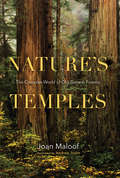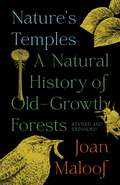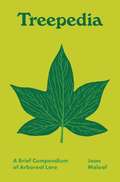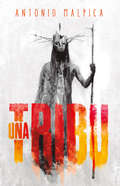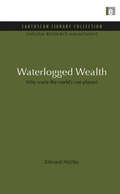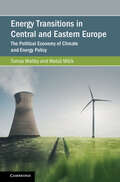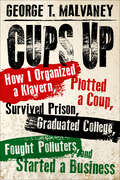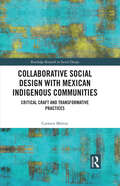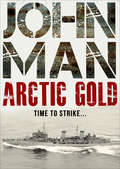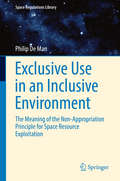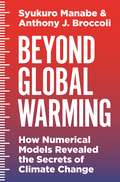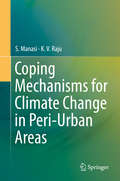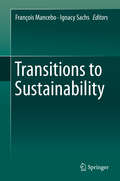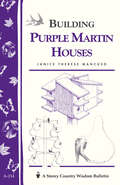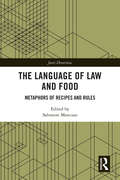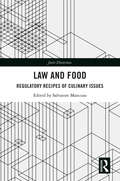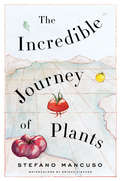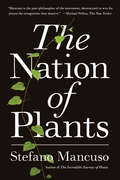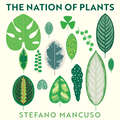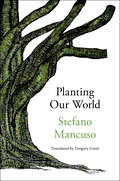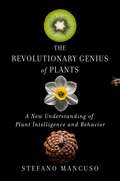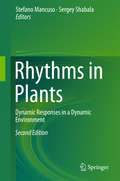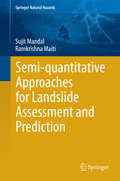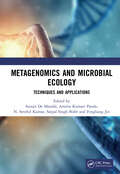- Table View
- List View
Nature's Temples: The Complex World of Old-Growth Forests
by Joan Maloof“Maloof eloquently urges us to cherish the wildness of what little old-growth woodlands we have left. . . . Not only are they home to the richest diversity of creatures, but they work hard for humans too.” —New York Times Book Review An old-growth forest is one that has formed naturally over a long period of time with little or no disturbance from humankind. They are increasingly rare and largely misunderstood. In Nature’s Temples, Joan Maloof, the director of the Old-Growth Forest Network, makes a heartfelt and passionate case for their importance. This evocative and accessible narrative defines old-growth and provides a brief history of forests. It offers a rare view into how the life-forms in an ancient, undisturbed forest—including not only its majestic trees but also its insects, plant life, fungi, and mammals—differ from the life-forms in a forest manipulated by humans. What emerges is a portrait of a beautiful, intricate, and fragile ecosystem that now exists only in scattered fragments. Black-and-white illustrations by Andrew Joslin help clarify scientific concepts and capture the beauty of ancient trees.
Nature's Temples: A Natural History of Old-Growth Forests Revised and Expanded
by Joan MaloofAn impassioned case for the importance of ancient forests and their preservationStanding in an old-growth forest, you can instinctively sense the ways it is different from forests shaped by humans. These ancient, undisturbed ecosystems are increasingly rare and largely misunderstood. Nature’s Temples explores the science and alchemy of old-growth forests and makes a compelling case for their protection.Many foresters are proponents of forest management, while ecologists and conservation biologists believe that the healthiest forests are those we leave alone. Joan Maloof brings together the scientific data we have about old-growth forests, drawing on diverse fields of study to explain the ecological differences among forests of various ages. She describes the life forms and relationships that make old-growth forests unique—from salamanders and micro-snails to plants that communicate through fungi—and reveals why human attempts to manage forests can never replicate nature’s sublime handiwork. This revised and expanded edition also sheds new light on the special role forests play in removing carbon from the atmosphere and shares what we know about the interplay between wildfires and ancient forests.With drawings by Andrew Joslin that illustrate scientific concepts and capture the remarkable beauty of ancient trees, Nature’s Temples invites you to discover the power of these fragile realms that are so inextricably connected to our planet, our fellow species, and our spirits.
Treepedia: A Brief Compendium of Arboreal Lore (Pedia Books)
by Joan MaloofA captivating A–Z treasury for the tree hugger in all of usTreepedia is an entertaining and fact-filled illustrated compendium of tree lore. Featuring nearly 100 entries—on topics ranging from tree ecology and conservation to the role of trees in religion, literature, art, and movies—this enticing collection is a celebration of all things arboreal.In this charming book, Joan Maloof explains the difference between a cedar and a cypress, and reveals where to find the most remarkable trees on the planet. She tells the story behind the venerable Bodhi Tree, and describes peculiar species like baobabs and Fitzroya. Maloof profiles legendary conservationists such as Julia "Butterfly" Hill, John Muir, Wangari Maathai, and Ken Wu. She discusses reforestation, proforestation, emerald ash borers, the ents from The Lord of the Rings, culturally modified trees, the ill-fated and controversial Redwood Summer, and much more. The book's portable size makes it the perfect travel companion no matter where your love of the forest may lead you.With enchanting illustrations by Maren Westfall, Treepedia is a fun and informative book that is guaranteed to inspire anyone who has ever enjoyed a walk in the woods.Features a real cloth cover with an elaborate foil-stamped designUses 100 percent recycled, uncoated, wood-free paper
Una tribu
by Antonio Malpica"Cada quién lleva un tatuaje distinto al de todos los demás en su interior. Y eso, a fin de cuentas, es su mayor fortaleza". "A veces siento que todo lo que impide al ser humano caminar descalzo por la hierba es una gran mentira." El gran jefe Tenaya y su pueblo habitan plácidamente el valle prohibido de Yosemite, a los pies del Capitán, el monolito preferido que hoy en día escalan los montañistas más atrevidos. Pero en 1850, aquella tribu tuvo que enfrentar una persecución sin tregua, una partida de ajedrez con los invasores del territorio piel roja. Petirrojo, hijo de Tenaya, sabe que su gente es de espíritu despreocupado, pero en su interior bullen las tribulaciones: la inseguridad frente a los talentos de sus hermanos, carismáticos y decididos; el temor de defraudar a su padre, y la vacilación ante el amor de Luz de Día, su amada desde niños. ¿Quién no ha temido quedar mal conquienes más le importan? A Tenaya le basta una vida simple y feliz para que su paso por la tierra sea provechoso, pero en ocasiones se necesita demostrar algo, a sí mismo y a los demás. Hasta ahora, Petirrojo no sabe para qué está en el mundo y se lo reprocha, pero se dará cuenta de que se necesita algo más que fuerza y astucia para vencer al enemigo, y poder así ser digno y libre. ¿Acaso una persona o una nación entera dejaría de existir si no alcanzara un sitio en la memoria del mundo? ¿Qué audacia tan grande se necesitará intentar en esta vida para que los demás te recuerden?
Waterlogged Wealth: Why waste the world's wet places? (Natural Resource Management Set)
by Edward MaltbyDon't drain the swamp! Man's traditional response to swamps, marshes and bogs has been to drain them. But wetlands are not wastelands. Coastal marshes are among the world's most productive ecosystems. They make many commercial fisheries possible and protect coasts from floods and storm surges. Wetlands are pollution filters, water reservoirs. They are among the last wild places on earth, offering homes to endangered plants, birds and animals. Attitudes to wetlands are changing, but not fast enough. As scientists are documenting the wealth in wet places, governments and developers are draining them, damming them, logging them and building resort hotels where ', they once were. Destruction is usually a poor trade-off: well-managed wetlands in Louisiana are producing fortunes in seafood and timber. Waterlogged wealth examines the value of swamps and marshes, as well as the threats against them. In doing so it takes the reader to some of the world's most bizarre landscapes: the 'inland delta' of the Niger River in drought-stricken Mali; the wildlife-rich Okavango swamps of Botswana; the waterlogged Sunderban forests of India and Bangladesh, where tigers eat fish and crabs. Civilisation began around wetlands; today's civilisation has good reason to leave them wet and wild. Dr Edward Maltby is a lecturer in geography at the University of Exeter(UK). He has done extensive research on wetlands both in the North (UK, US, Canada) and the South (Fiji, Jamaica, India and the Falklands/Malvinas Islands). He is on the IUCN Wetland Programme Advisory Committee. Originally published in 1986
Energy Transitions in Central and Eastern Europe: The Political Economy of Climate and Energy Policy (Cambridge Studies on Environment, Energy and Natural Resources Governance)
by null Tomas Maltby null Matúš MišíkThis book examines the mutual interplay of climate and energy policies in eleven Central and Eastern European countries in the context of the EU's energy transition. Energy security has long been prioritised in the region and has shaped not only national climate and energy policy, but also EU-level policy-making and implementation. Whilst the region shares economic, institutional and historical energy supplier commonalities it is not homogenous, and the book considers the significant differences between the preferences and policies of these member states. Chapters also explore the effect of the EU on member states that have joined since 2004 and their influence on the EU's energy and climate policies and their role in highlighting the importance of the concepts of security and solidarity. The book highlights the challenges to, and drivers of, energy transitions in the region and compares these with those in global energy transitions.
Cups Up: How I Organized a Klavern, Plotted a Coup, Survived Prison, Graduated College, Fought Polluters, and Started a Business (Willie Morris Books in Memoir and Biography)
by George T. MalvaneyGeorge T. Malvaney's life epitomizes the old maxim that "You cannot make this stuff up." Combine a young Klansman from Mississippi, an armed coup attempt in the Caribbean, a stay in prison, and a life-changing epiphany, and you have but half of this swashbuckling tale. Throw in the worst man-made ecological disaster in the history of the United States, and you have unleashed Malvaney's full life story. The Klansman, the soldier of fortune, the wild-eyed prisoner transforms into a renowned leader of the Mississippi Gulf Coast cleanup effort in the wake of the BP Deepwater Horizon oil spill.In his too-crazy-not-to-be-true memoir, Malvaney chronicles what easily should be several lifetimes of adventure--and misadventure. Growing up in a close-knit family in Jackson, Mississippi, the young Malvaney preferred woods and swamps to the drudgery of high school. He dropped out, enlisted in the Navy, and shortly afterwards joined the Ku Klux Klan. While onboard, he organized a branch of the Klan, corrupting and endangering his crewmen. After his discharge, he answered a mercenary call to take part in an invasion of Dominica, a Caribbean fiasco known as the "Bayou of Pigs." That madness landed him in a federal penitentiary. And there, somehow, he vowed to turn his life around.Cups Up, a title drawn from the wake-up call shouted at prisoners, is a story of perseverance, cleansing, and redemption. It chronicles the roller coaster life of a high school dropout, ex-Klansman, ex-mercenary, ex-felon, and ex-con, who went on to become a college graduate, a hardnosed environmental regulator, and a widely respected top executive in a company with more than a thousand employees.
Collaborative Social Design with Mexican Indigenous Communities: Critical Craft and Transformative Practices (Routledge Research in Social Design)
by Carmen MalvarThis book builds on the work of anthropologists, designers, and ethnographers to develop an original methodology and framework for indigenous engagement and designer/non-designer collaboration in the field of social design. Following a collaborative case study conducted over a five-year period between the author, project team, and indigenous artisans in Mexico, the book outlines the practical challenges of design research, including funding, logistics, relationships between designers and communities, failures, successes, and pivots. Social design literature has often focused on introducing important questions to the design research process, but fails to deeply interrogate and demonstrate how these theories inform research projects in action, which can then be open to misinterpretation, bias, and unintended harmful consequences. Centering the indigenous communities, this book provides a detailed and clear example of not just why, but how design and designers can work authentically and responsibly through different approaches and systems. The book examines the specific cultural, epistemological and socio-political history of Mexico as it relates to colonization and indigenous peoples, exploring the systemic influences of globalization and grounding the research in its unique context. It includes field notes, conversations with the indigenous artisan communities, workshops and prototypes to offer unique insight into a detailed, collaborative social design initiative. This book intersects with the growing awareness of the necessity of decolonial approaches to design across the world and will be an important and useful study for academics, students and researchers in social design, sustainable development, cultural studies and anthropology.
Arctic Gold
by John ManA man searches for the sunken treasure he once protected as a sailor in WWII in this “thrilling action story” from the acclaimed historian (Tom Kasey, author of Trade Off). Murmansk, Russia, 1942. The HMS Edinburgh is sailing deep in Russian territory, a bulwark against Nazi invaders. Among the eight-hundred-strong crew is Mike Cox, a sixteen-year-old boy from the East End, London who is about to be thrown into the heat of war. A Russian ship approaches the Edinburgh with a very precious cargo—over a thousand tons of gold—as payment from the Soviet Union for the Royal Navy’s protection. Now the English ship is tasked with safeguarding a fortune as well as the Barents Sea. But when a German U-boat fires torpedoes at the Edinburgh’s hull, the crew must fight for their lives . . . and Mike is one of only a few survivors to escape from the wreck as the gold sinks eight hundred feet to the bottom of the sea. After making his way back to London, Mike finds himself more alone than ever. He starts training to become a diver with one objective in mind: to rescue that precious Arctic gold. But he’ll have to act quick—he’s not the only one looking for it . . .
Exclusive Use in an Inclusive Environment
by Philip De ManThis book aims to find a workable interpretation of the non-appropriation principle that is compatible with both the existing international space law framework and the move of the private space industry towards the mining of asteroids and other celestial bodies. It does so by analysing the rules on the use of orbits as limited natural resources as a concrete indication of how space resources can be exploited by one user while respecting the non-appropriation principle and the interests of other users in space. This analysis is complemented by a thorough review of the meaning of property rights in the context of the existing international space law regime. This allows the author to distinguish between the lawful exploitation and unlawful appropriation of resources in a manner that could pave the way for a workable asteroid mining regime that takes into account the needs of individual companies and the international community. Exclusive use in an inclusive environment frames the legal regime of the exploitation of natural resources in outer space as the most pressing example to date of the tension that arises between the rights of a single spacefaring actor and the interests of the broader international community. Though academic in its approach in dealing with one of the most fundamental issues of space law to date, the book has very practical ambitions. By offering a pragmatic interpretation of the space law principles that are likely to remain the legal foundations of asteroid mining for the foreseeable future, Exclusive use in an inclusive environment hopes to inform academics, practitioners and policymakers alike in their future attempts at working out a fair, equitable and effective management regime for the exploitation of natural resources in outer space.
Beyond Global Warming: How Numerical Models Revealed the Secrets of Climate Change
by Syukuro Manabe Anthony J. BroccoliA definitive account of how we have come to understand the fundamental processes behind global warmingSyukuro Manabe is perhaps the leading pioneer of modern climate modeling. Beyond Global Warming is his compelling firsthand account of how the scientific community came to understand the human causes of climate change, and how numerical models using the world’s most powerful computers have been instrumental to these vital discoveries.Joined by atmospheric scientist Anthony Broccoli, Manabe shows how climate models have been used as virtual laboratories for examining the complex planetary interactions of atmosphere, ocean, and land. Manabe and Broccoli use these studies as the basis for a broader discussion of human-induced global warming—and what the future may hold for a warming planet. They tell the stories of early trailblazers such as Svante Arrhenius, the legendary Swedish scientist who created the first climate model of Earth more than a century ago, and they provide rare insights into Manabe’s own groundbreaking work over the past five decades. Expertly walking readers through key breakthroughs, they explain why increasing atmospheric carbon dioxide has caused temperatures to rise in the troposphere yet fall in the stratosphere, why the warming of the planet’s surface differs by hemisphere, why drought is becoming more frequent in arid regions despite the global increase in precipitation, and much more.Authoritative and illuminating, Beyond Global Warming is an invaluable insider’s look at some of today’s most cutting-edge Earth science, and a rare window into a brilliant scientific mind.
Coping Mechanisms for Climate Change in Peri-Urban Areas
by S. Manasi K. V. RajuThis book discusses the dynamics and resource management qualities of the peri-urban interface to address climate change consequences, focusing on the peri-urban region of the global city of Bengalaru. In 5 chapters, the authors document the unique challenges experienced in peri-urban areas, including soil-water vegetation dynamics, local and regional impacts on water bodies (surface and groundwater), food production issues, and the inhibited adaptive capacity of local communities. The book also provides knowledge on implementations of environmental management by local institutions, government interventions that have acted as catalysts in promoting community based adaptation strategies, and the physical, social and economic aspects of rural-urban dynamics. The book not only adds to the scarce existing literature on peri-urban contexts, but also addresses the role of culture in protecting ecological landscapes and how traditions play an important role in coping with climate change. Furthermore, the authors expand on these climate change coping mechanisms in peri-urban areas, taking into account local cultural factors and interesting governance interventions in the context of health. The book will be of interest to planners, policy makers, and students and researchers engaged in rural-urban dynamics and climate change adaptation.
Transitions to Sustainability
by François Mancebo Ignacy SachsThis book calls for the conditions of transition to sustainability: How to take into consideration new global phenomena such as and of the dimension of climate change, the depletion of natural resources, financial crises, demographic dynamics, global urbanization, migrations and mobility, while bearing in mind short-term or local place-based issues, such as social justice or quality of life? Meeting this challenge requires an inclusive approach of sustainability. It is a matter of designing a new social contract: Sustainability requires more than developing the right markets, institutions and metrics, it requires social momentum. To do so, many issues need a clear and complete answer: How to link social justice with sustainability policies? What governance tools to do so? What linkage between one decision-making level and the other? These are major issues to design sound transitions to sustainability.
Building Purple Martin Houses: Storey's Country Wisdom Bulletin A-214 (Storey Country Wisdom Bulletin Ser.)
by Janice Therese MancusoAttract and maintain a purple martin colony! Janice Mancuso shows you exactly how to do it. From finding the right site and choosing the best housing materials to constructing a martin house with suitable entrance holes and predator guards, you’ll find everything you need to know in this concise guide.
The Language of Law and Food: Metaphors of Recipes and Rules (Juris Diversitas)
by Salvatore MancusoThis book reconsiders the use of food metaphors and the relationship between law and food in an interdisciplinary perspective to examine how food related topics can be used to describe or identify rules, norms, or prescriptions of all kinds. The links between law and food are as old as the concept of law. Many authors have been using such links in creative ways to express specific features of law. This is because the language of food and cooking offers legal thinkers and teachers mouth-watering metaphors, comparing rules to recipes, and their combination to culinary processes. This collection focuses on this relationship between law and food and takes us far beyond their mere interaction, to explore different ways of using these two apparently so diverse elements to describe different phenomena of the legal reality. The authors use the link between food and law to describe different aspects of the legal landscape in different areas and jurisdictions. Bringing together metaphors and indirect correlations between law and food, the book explores different models of approaching legal issues and considering different legal challenges from a completely new perspective, in line with the multidisciplinary approach that leads comparative legal studies today and, to a certain extent, revisiting and enriching it. With contributions in English and French, the book will be of interest to academics and researchers working in the areas of law and food, law and language, and comparative legal studies.
Law and Food: Regulatory Recipes of Culinary Issues (Juris Diversitas)
by Salvatore MancusoThis book presents a range of insights on the relationship between food and law. Over time, religions have multiplied food prohibitions and prescriptions, customs have redistributed land, shared its occupancy in creative ways, or favoured communal property so that everyone could have access to food. In turn, laws have multiplied to facilitate food trade, security, safety, traceability, and also to promote and protect food and wine production, using trademarks and geographical denominations. This volume brings a comparative and interdisciplinary approach to examine some of the most heavily debated issues in the interaction between food, in all forms, and the law. Topics covered include food security, food safety, food quality, intellectual property, and consumer protection. As well as highlighting current issues, the work also points to new challenges in this field. The book will be a valuable resource for researchers and policy-makers working in the area of Food Law and Comparative Law.
The Incredible Journey of Plants
by Stefano MancusoIn this richly illustrated volume, a leading neurobiologist presents fascinating stories of plant migration that reveal unexpected connections between nature and culture.When we talk about migrations, we should study plants to understand that these phenomena are unstoppable. In the many different ways plants move, we can see the incessant action and drive to spread life that has led plants to colonize every possible environment on earth. The history of this relentless expansion is unknown to most people, but we can begin our exploration with these surprising tales, engagingly told by Stefano Mancuso. Generation after generation, using spores, seeds, or any other means available, plants move in the world to conquer new spaces. They release huge quantities of spores that can be transported thousands of miles. The number and variety of tools through which seeds spread is astonishing: we have seeds dispersed by wind, by rolling on the ground, by animals, by water, or by a simple fall from the plant, which can happen thanks to propulsive mechanisms, the swaying of the mother plant, the drying of the fruit, and much more. In this accessible, absorbing overview, Mancuso considers how plants convince animals to transport them around the world, and how some plants need particular animals to spread; how they have been able to grow in places so inaccessible and inhospitable as to remain isolated; how they resisted the atomic bomb and the Chernobyl disaster; how they are able to bring life to sterile islands; how they can travel through the ages, as they sail around the world.
The Nation of Plants
by Stefano MancusoIn this playful yet informative manifesto, a leading plant neurobiologist presents the eight fundamental pillars on which the life of plants—and by extension, humans—rests.Even if they behave as though they were, humans are not the masters of the Earth, but only one of its most irksome residents. From the moment of their arrival, about three hundred thousand years ago—nothing when compared to the history of life on our planet—humans have succeeded in changing the conditions of the planet so drastically as to make it a dangerous place for their own survival. The causes of this reckless behavior are in part inherent in their predatory nature, but they also depend on our total incomprehension of the rules that govern a community of living beings. We behave like children who wreak havoc, unaware of the significance of the things they are playing with. In The Nation of Plants, the most important, widespread, and powerful nation on Earth finally gets to speak. Like attentive parents, plants, after making it possible for us to live, have come to our aid once again, giving us their rules: the first Universal Declaration of Rights of Living Beings written by the plants. A short charter based on the general principles that regulate the common life of plants, it establishes norms applicable to all living beings. Compared to our constitutions, which place humans at the center of the entire juridical reality, in conformity with an anthropocentricism that reduces to things all that is not human, plants offer us a revolution.
The Nation of Plants: The International Bestseller
by Stefano MancusoAs plants see it, humans are not the masters of the Earth but only one of its most unpleasant and irksome residents. They have been on the planet for only about 300,000 years ago (nothing compared to the three billon years of plant evolution), yet have changed the conditions of the planet so drastically as to make it a dangerous place for their own survival. It's time for the plants to offer advice.In this playful, philosophical manifesto, Stefano Mancuso, expert on plant intelligence, presents a new constitution on which to build our future as beings respectful of the Earth and its inhabitants. These eight articles - the fundamental pillars on which plant life is based - must henceforth regulate all living beings.
Planting Our World
by Stefano MancusoWith fun, fascinating vignettes, a renowned neurobiologist illuminates the interconnectedness of plant life and how we can learn from it to better plan our communities.We animals account for a paltry 0.3% of the planet&’s biomass while plants add up to 85%. And when, with just a little training, we are able to look at the world without seeing it solely as humanity&’s playground, we cannot help but notice the ubiquity of plants. They are everywhere, and their stories are inevitably bound up with ours. As every tree in a forest is linked to all the others by an underground network of roots, uniting them to form a super organism, so plants constitute the nervous system, the plan that is the &“greenprint&” of our world. To ignore the existence of this plan is one of the most serious threats to the survival of our species. In this latest book, the brilliant Stefano Mancuso is back to illuminate the greenprint of our world. He does it through unforgettable stories starring plants that combine an inimitable narrative style with remarkable scientific rigor, from the story of the red spruce that gave Stradivarius the wood for his fourteen violins, to the Kauri tree stump, kept alive for decades by the interconnected root system of nearby trees. From the mystery of the slipperiness of the banana skin to the plant that solved the &“crime of the century,&” the Lindbergh kidnapping, by way of wooden ladder rungs.
The Revolutionary Genius of Plants: A New Understanding of Plant Intelligence and Behavior
by Stefano Mancuso"In this thought-provoking, handsomely illustrated book, Italian neurobiologist Stefano Mancuso considers the fundamental differences between plants and animals and challenges our assumptions about which is the &‘higher&’ form of life.&” —The Wall Street Journal&“Fascinating…full of optimism…this quick, accessible read will appeal to anyone with interest in how plants continue to surprise us.&” —Library JournalDo plants have intelligence? Do they have memory? Are they better problem solvers than people? The Revolutionary Genius of Plants—a fascinating, paradigm-shifting work that upends everything you thought you knew about plants—makes a compelling scientific case that these and other astonishing ideas are all true.Plants make up eighty percent of the weight of all living things on earth, and yet it is easy to forget that these innocuous, beautiful organisms are responsible for not only the air that lets us survive, but for many of our modern comforts: our medicine, food supply, even our fossil fuels. On the forefront of uncovering the essential truths about plants, world-renowned scientist Stefano Mancuso reveals the surprisingly sophisticated ability of plants to innovate, to remember, and to learn, offering us creative solutions to the most vexing technological and ecological problems that face us today. Despite not having brains or central nervous systems, plants perceive their surroundings with an even greater sensitivity than animals. They efficiently explore and react promptly to potentially damaging external events thanks to their cooperative, shared systems; without any central command centers, they are able to remember prior catastrophic events and to actively adapt to new ones. Every page of The Revolutionary Genius of Plants bubbles over with Stefano Mancuso&’s infectious love for plants and for the eye-opening research that makes it more and more clear how remarkable our fellow inhabitants on this planet really are. In his hands, complicated science is wonderfully accessible, and he has loaded the book with gorgeous photographs that make for an unforgettable reading experience. The Revolutionary Genius of Plants opens the doors to a new understanding of life on earth.
Rhythms in Plants
by Stefano Mancuso Sergey ShabalaThis second edition of a well-received book focuses on rhythmic behaviour in plants, which regulates all developmental and adaptive responses and can thus be regarded as quintessential to life itself. The chapters provide a timely update on recent advances in this field and comprehensively summarize the current state of knowledge concerning the molecular and physiological mechanisms behind circadian and ultradian oscillations in plants, their physiological implications for growth and development and adaptive responses to a dynamic environment. Written by a diverse group of leading researchers, the book will spark the interest of readers from many branches of science: from physicists and chemists wishing to learn about the multi-faceted rhythms in plants, to biologists and ecologists involved in the state-of-the-art modelling of complex rhythmic phenomena.
Semi-quantitative Approaches for Landslide Assessment and Prediction
by Sujit Mandal Ramkrishna MaitiIn the present authors attempted to have a clear insight into the interworking of geotectonic, geomorphic, hydrologic and anthropogenic factors leading to landslide in the Shiv khola Watershed, the most worst affected region of Darjiling Himalaya. This book includes the parameters responsible for landslide events in mountainous areas. It provides knowledge and understanding to the local people, planners, and policy makers about the causes and consequences of landslides as well as provides a suitable method to mitigate the landslips. The book deals with the role of land, water and soil in landslide phenomena. These three attributes have been described in terms of critical rainfall, critical slope, critical height and changes and development of drainage network in landslides. Mitigations and site-specific management options are evaluated considering the roles of local govt. , community and other organizations in both pre-slide and post-slide periods. Various scientific methods have been used to assess the landslides that will bring about tremendous help to researchers in the field. In particular, Researchers in Mountain Geomorphology and Geological and Geographical Society will get tremendous help from some topics such as 1-D slope stability model, SCS Curve Number Technique, Assessment of morphological parameters, application of RS & GIS, Application of Analytical Hierarchy Process. Semi-quantitative approach is followed for understanding spatial distribution of cohesion, friction angle slope, lithology and lineaments, drainage, upslope contributing area, land use and land cover types etc. This book also reveals some techniques and models for initiating slope instability.
Metagenomics and Microbial Ecology: Techniques and Applications
by Surajit De Mandal Amrita Kumari Panda Nachimuthu Senthil Kumar Satpal Singh Bisht Fengliang JinMicroorganisms comprise the greatest genetic diversity in the natural ecosystem, and characterization of these microbes is an essential step towards discovering novel products or understanding complex biological mechanisms. The advancement of metagenomics coupled with the introduction of high-throughput, cost-effective NGS technology has expanded the possibilities of microbial research in various biological systems. In addition to traditional culture and biochemical characteristics, omics approaches (metagenomics, metaproteomics, and metatranscriptomics) are useful for analyzing complete microbial communities and their functional attributes in various environments. Metagenomics and Microbial Ecology: Techniques and Applications explores the most recent advances in metagenomics research in the landscape of next-generation sequencing technologies. This book also describes how advances in sequencing technologies are used to study invisible microbes as well as the relationships between microorganisms in their respective environments. Features: Covers a wide range of concepts, investigations, and technological advancement in metagenomics at the global level. Highlights the novel and recent approaches to analyze microbial diversity and its functional attributes. Features a range of chapters that present an introduction to the field and functional insight into various ecosystems.
The Fractal Geometry Of Nature
by Benoit MandelbrotExplore the wondrously complex repeating shapes of the natural world in The Fractal Geometry of Nature. Written in a style that is accessible to a wide audience, computer scientist, professor, mathematician, economist, and visionary Benoit B Mandelbrot's fascinating work has inspired popular interest in the geometry inherent in the natural world. Unlike the squares, circles, spheres, and cones of fundamental geometry, nature has rough edges and no straight lines or perfect curves. Mandelbrot observed that, even with this roughness, there still exists a kind of symmetry, which he dedicated his work to document and study. This became the basis for his development of a new kind of geometry; indeed, he coined the term "fractal."
